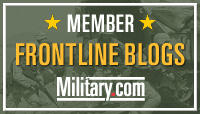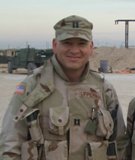A typical day at work
The following is an article about our unit that was published in the Dallas Morning News. The author enumerates his experience with one of our platoons when he was imbedded for a day. The platoon was conducting combat patrols, which is something they do almost every day, so this is just a typical day at the office for them.
LT Garcia was one of my Platoon leaders when I was a company commander. He is an excellent leader and an outstanding officer and this article aptly reflects that fact. It's also interesting to note that if not for the young shepard boy the platoon may not have found the IED that day. But because of his help it is very likley an American soldier was saved from injury or worse. This is more evidence of the typical citizen's disdain for the insurgency.
It's a bit of a lengthy read, but well worth it.
LT Garcia was one of my Platoon leaders when I was a company commander. He is an excellent leader and an outstanding officer and this article aptly reflects that fact. It's also interesting to note that if not for the young shepard boy the platoon may not have found the IED that day. But because of his help it is very likley an American soldier was saved from injury or worse. This is more evidence of the typical citizen's disdain for the insurgency.
It's a bit of a lengthy read, but well worth it.
| For Texas unit, job is explosive. Guard members hunt for deadly homemade bombs along Iraqi route. By VERNON SMITH JR. Staff Writer Published June 4, 2005 |
The young Iraqi shepherd spoke little English but found a way to get the Texas soldiers' attention. "Boom!" he said, pointing to a culvert in his field. The shepherd approached on a recent morning as the Texas Army National Guard convoy stopped to scour a section of highway for the deadly homemade bombs used widely by Iraq's insurgency. Since they landed in Iraq in January, the 56th Brigade Combat Team has had the dangerous job of searching for roadside bombs along one of the U.S. military's major supply routes. The crude bombs have killed and maimed hundreds of U.S. and allied troops and have sparked intense pressure for the Pentagon to provide American forces with more better-armored vehicles. After confirming the shepherd's discovery - two 122 mm mortar rounds bound together in the culvert - soldiers stopped traffic on the six-lane highway in both directions, and cars soon began to stack up. It would be more than five hours before Navy experts arrived to destroy the mortars, enough time for the Texas soldiers to experience the improvisational rhythm of life in a world thousands of miles from home. Hours before the 56th BCT soldiers inspected the highway, ditches and culverts for bombs, Lt. Ben Garcia of San Angelo reviewed the game plan for the morning's patrol. "We're going to keep them off us, today, right?" said Lt. Garcia, standing in front of his team inside a room with a foosball table and shelves crammed with paperbacks and breakfast cereal. "Hoo-ah!" they responded. "Nobody is going to get close to us!" "Hoo-ah!" The soldiers know the drill, but Lt. Garcia leaves little to chance. The briefing is as much a pep talk as it is a mini-lecture on the various insurgent tactics and threats that await outside Camp Scania, about 60 miles south of Baghdad. Iraq's modern network of highways and paved roads provides coalition forces high-speed movement across the country. The same highways also make them vulnerable to enemy attacks. Across Iraq, U.S. military convoys are routinely hit by attackers who try to crash their bomb-laden vehicles into a convoy. Last month, 80 U.S. troops were killed, many in multiple blasts caused by suicide attackers, car bombs or roadside explosions, making it the second-deadliest month this year. Signs warning motorists to stay clear hang on the back of each 56th BCT Humvee, and a driver who ventures too close risks a warning shot or worse. Parked or abandoned vehicles along the highway also warrant concern. "If we see a vehicle on the side of the road and nobody is in or near it, that's suspicious," Lt. Garcia said. "In this country, these people do not leave anything of value alone by itself." The soldiers are reminded to stay alert for people and vehicles along traffic chokepoint areas where the convoy may slow and bunch up, making itself vulnerable to an ambush. Attackers have also dropped bombs, known by the military as improvised explosive devices, or IEDs, from highway overpasses and dangled them from bridge guardrails, making Humvee gunners especially vulnerable. "Anybody you see watching you intently could be somebody with an IED," Lt. Garcia said. Maj. Phillip Lunt, an intelligence officer from Killeen, said insurgents have found creative ways of disguising the weapons along roads traveled by military convoys. IEDs have been hidden in soda cans, plastic trash bags and animal carcasses and under piles of rubbish. They have been stuffed into the frame of a child's bicycle and encased in concrete to make them look like harmless concrete blocks. "They can look like anything," Maj. Lunt said. Many of the weapons are made from artillery shells, mortar rounds and other unsecured munitions that can be found across Iraq. The bombs often are detonated from a distance by a remote control device like a garage door opener, car alarm, doorbell or cellphone. Since January, 56th BCT route clearance operations have uncovered at least 28 IEDs and munitions caches. Seven of the brigade's 3,000 soldiers have been injured in roadside bomb incidents. But the brigade has suffered no fatalities, a fact that the brigade commander, Col. James K. "Red" Brown, attributed to the armored vehicles and the protective helmet and vest each soldier wears. Col. Brown said although armor can't guarantee total safety, "every Humvee we put outside the wire is Level 2 or better." Level 2 refers to factory-made kits with thick steel doors and anti-ballistic windows added to trucks or Humvees. Col. Brown said he was awaiting delivery of 60 new factory-armored Humvees. "If you look at coalition vehicles, no other country has anything that even comes close to the level of protection the United States has on its wheeled vehicles," Col. Brown said. Spc. Jerome Hawkins, a member of the unit, was riding in a convoy a few months ago when a bomb exploded between two Humvees approaching an overpass near Abu Ghraib, a western suburb of Baghdad. Two men were seen sprinting from the scene. "They didn't time it right, which was a blessing on our part," said Spc. Hawkins, an Arlington resident. Fifteen minutes after the explosion, another Army convoy up ahead found a bomb hanging from a bridge overpass and closed the highway, he said. "I think everybody was a little shocked that day," Spc. Hawkins said. "We had just rolled through Ramadi, where they have Marines in tanks on all the bridges. So everybody got a little bit relaxed. I think when all this happened, it got everybody's attention." Back on the highway where the shepherd located the latest bomb, a few Iraqi drivers waved tentatively to the Texas soldiers at the roadblock before turning onto an impromptu detour that sent them in the opposite direction. But in the relentless sun, most of the drivers wore resigned, grim-faced expressions. The detour required sedans, pickups, station wagons and buses to drive off the pavement and across a winding, rutted dirt path more suited to four-wheel-drive sport utility vehicles. Dust clouds swirled around women in black abayas and other passengers forced to step out of vehicles so that drivers could get past the worst spots. Although pleased about the morning's discovery, the soldiers grew more anxious by the hour. Wide open and stuck on the highway, they were a perfect target for trouble. At one point, a gunshot from an unknown source sent them sprinting for cover. "I got eyes on a guy standing straight up at 3 o' clock," shouted Sgt. Brad Raphelt, a Humvee gunner from Arlington, training his binoculars at a figure in a field about 300 yards from the highway. "He's been standing out there ever since we pulled up." Sgt. Jose Peredez of San Saba, the Humvee's commander, grabbed his binoculars for a look. He told Spc. Michael Scantling of Dublin to get on the radio and alert the rest of the convoy so that more soldiers could help watch the man. At one point, an ambulance crept up to the roadblock, creating a brief frenzy as soldiers pointed their weapons and yelled for the driver and passenger to get out of the vehicle. Soldiers searched the ambulance because insurgents in Iraq reportedly have used them in car bomb attacks and to transport weapons. The driver told an Iraqi translator that he needed to go through the roadblock to reach a hospital, but soldiers told him to turn around and find an alternate route. The tension on the road eased when a flock of sheep paraded past the convoy to an adjacent field. Finally, the team of Navy bomb demolition experts and Polish army soldiers arrived, and a small camera-equipped robot attached an explosive charge to the mortars. Some soldiers reached into their pockets for cameras, hoping to document the blast for their scrapbooks. With a thunderous explosion, the mortars in the shepherd's field were destroyed. The highway reopened and traffic returned to normal. "It's just a typical day out here," said Spc. Bruce Grove, a self-storage company operator from Lewisville, who pulled sentry duty at one of the roadblocks. "We see it all, and anything can happen." E-mail vsmith@dallasnews.com |


5 Comments:
You guys are awesome. Keep up the good work. Luv ya - Carol
Godspeed to you, as well as all the brave men & women who are fighting to end oppression everywhere.
good to finally see some good news. The papers usually talk about how many lives were lost and not how many were saved.
Thanks!
Thanks for posting that Baghdaddy. Gives us a good idea what you're up against. I applaud the reporter and the paper for the story. Take care.
Thank you for sharing about this.You are in our prayers everyday. Thank you for serving our country ! I wish there were better words then thank you because it is meant with all our hearts.
Post a Comment
<< Home